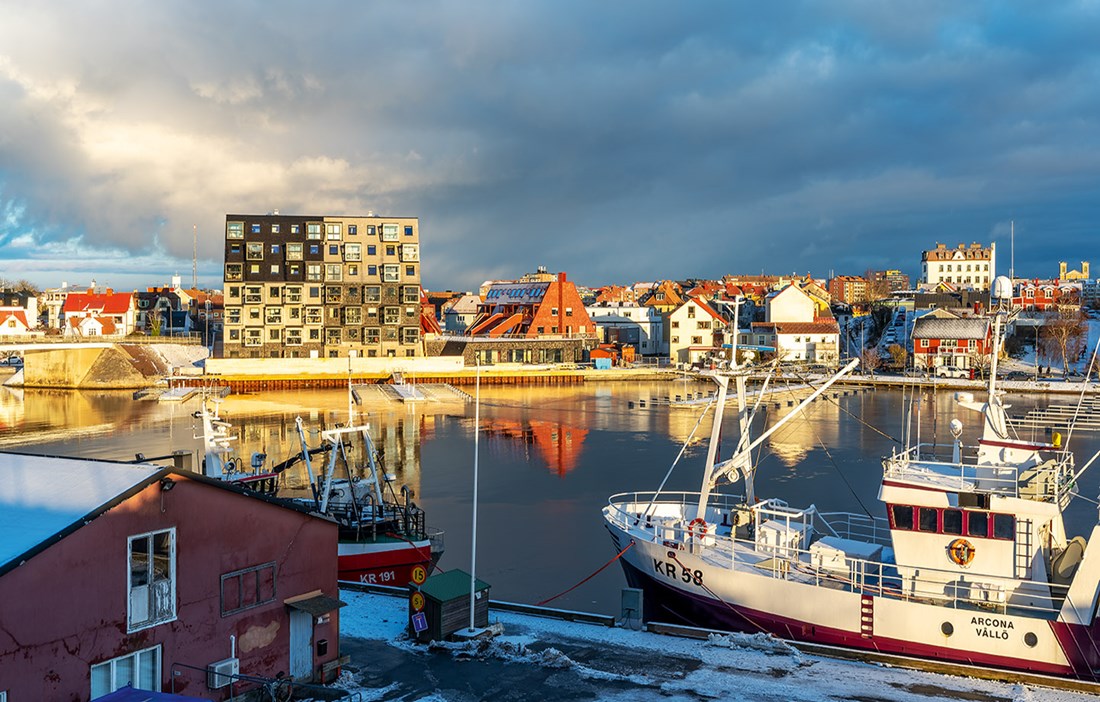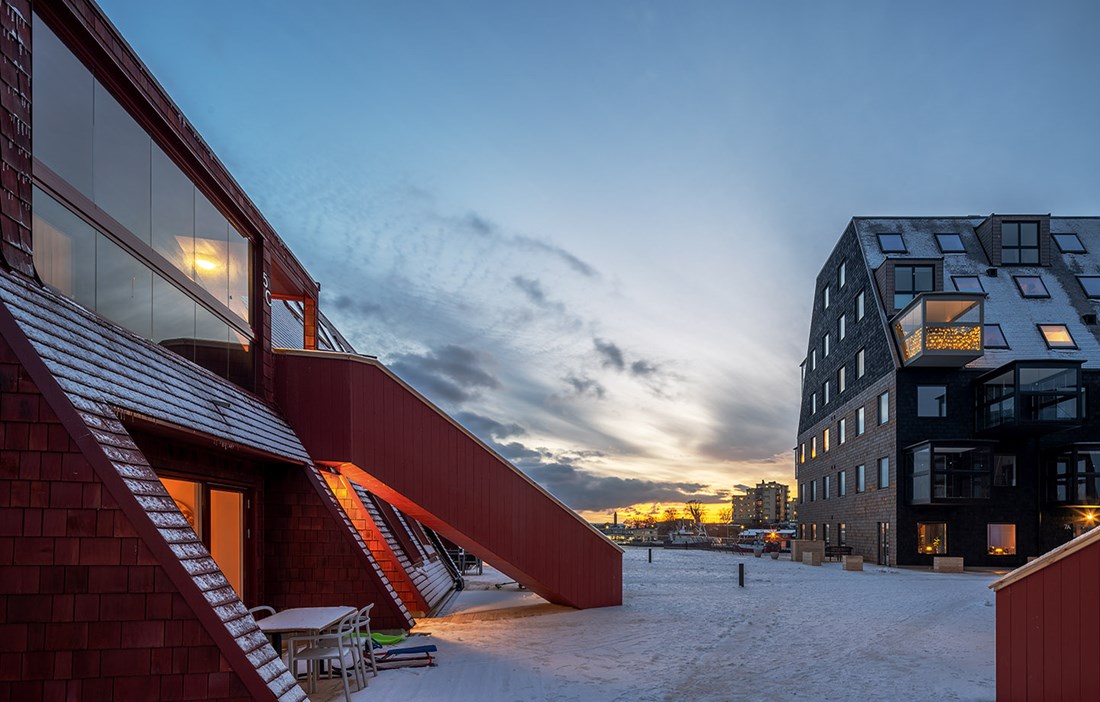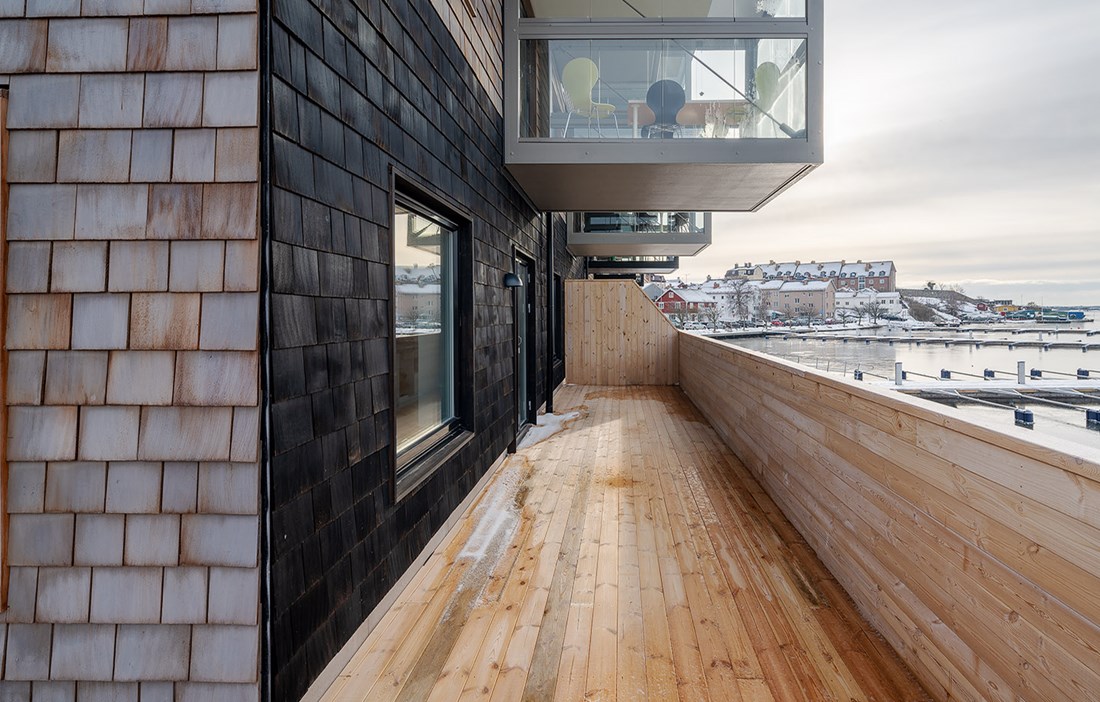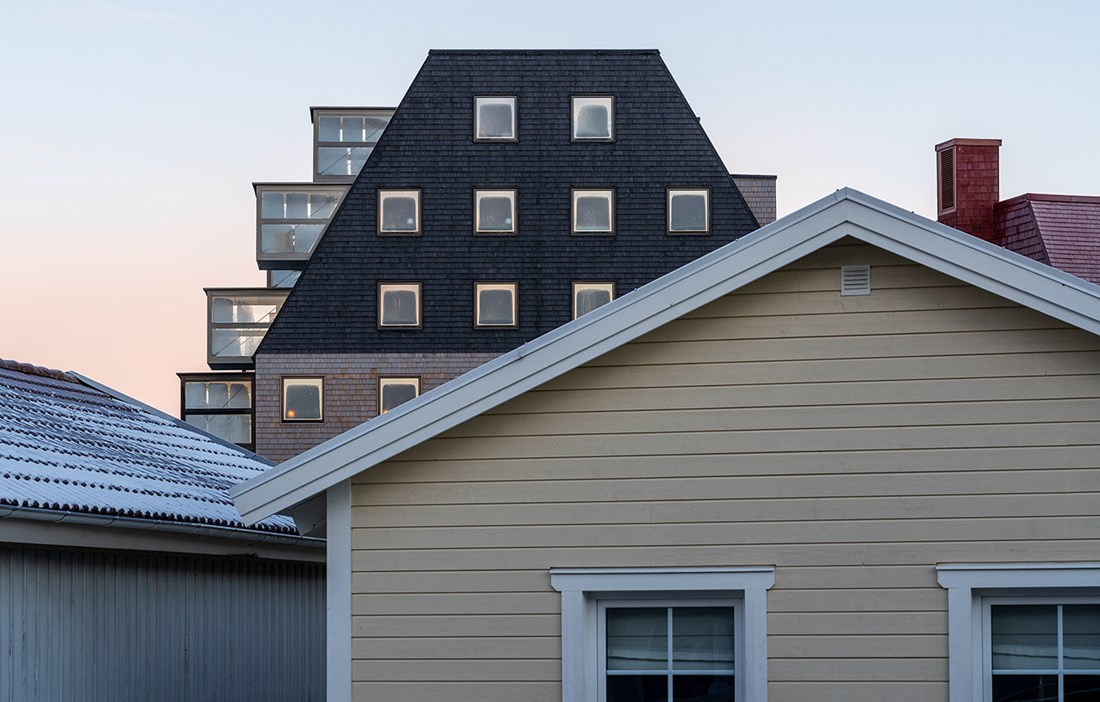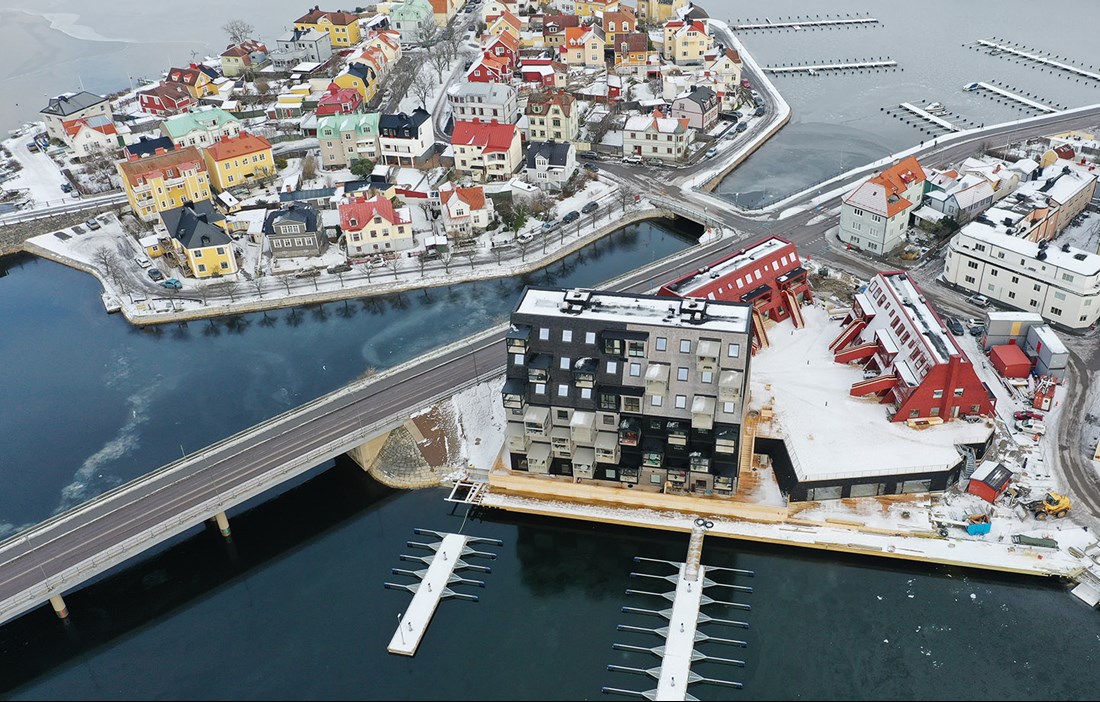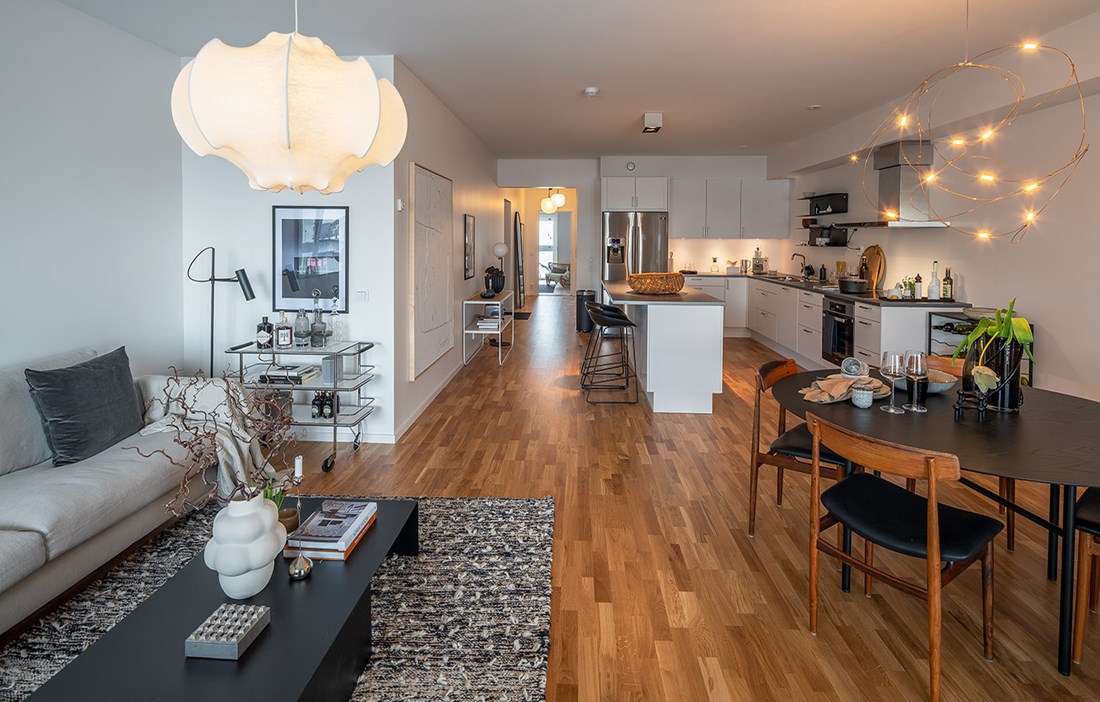Karlkrona’s town plan, with this many military buildings, squares, boulevards and three striking churches, reflects the ambition of Sweden at the height of its powers. It also includes several interesting wooden buildings on both large and small scale. The rope walk in the old naval harbour is one of the town’s oldest preserved buildings, and at 300 metres, it is the longest wooden building in the country. Amiralitetskyrkan from 1685 is Sweden’s biggest wooden church. Alongside the more monumental Karlskrona, there are
Kilströmskaj lies on a peninsula on the eastern flank of Björkholmen, right next to Saltöbron bridge. The project is the brainchild of Svensk Bostadsutveckling, a subsidiary of SBU Framtid, itself a collaborative enterprise owned by Wingårdhs Arkitektkontor, JSB Construction and Kai-Larsen Affärsutveckling. The company’s mission is to build apartment blocks in wood, with high design ideals, at attractive prices through industrial construction.
»The strength of our setup is that three different perspectives and areas of expertise are represented from the start on each project. We’re moving from project- to process-based working methods and we include the architect at an early stage,« explains Torsten Kai-Larsen, founder and CEO of SBU Framtid.
»Naturally, a World Heritage town with strong traditions and heritage from the late 17th century sets high standards for any new buildings. Initially, we therefore needed to convince the County Administrative Board that our proposal had relevance. One of the things we did was to track down the first town plan from the late 17th century, so we could place the site in a historical context. When you have an opportunity to build something new, it’s important to acknowledge the history, to look backwards while also looking forwards,« says Joakim Lyth.
The result is three unique wooden buildings with strong geometric forms and clear silhouettes that borrow characteristics from the landmarks of Karlskrona. One large and two smaller buildings define the site and create a distinct courtyard space. The different designs of the buildings have allowed for a wide variety of housing, with the 44 homes including everything from duplexes and apartments with the qualities of a terrace to units for combined living and retail at ground level. Pulling the roof line down makes the six- and four-storey buildings look lower than they are, and they have a distinctive silhouette that can be seen from way out at sea, just like the coast’s lighthouses and beacons.
The apartments on the ground floor have their own entrances and private outdoor spaces, while the others have glazed balconies that project at right angles from the façade for the best views. Beneath the buildings there is a shared garage, plus store rooms and utilities. To the south west, a stepped public area has been built up and a restaurant will be opening on the quayside in the spring.
»Our hope is that the people of Björkholmen and central Karlskrona will see the quay as a new social space for the public. And it’s by no means an afterthought. We want to make it clear that the area doesn’t just belong to the residents,« comments Torsten Kai-Larsen.
The project has not been plain sailing since Wingårdhs began the design work in autumn 2014. Challenges to the plans were taken through the courts, until the Land and Environment Court opted to reject the case in spring 2018.
ocation and proximity to the sea, but also the aesthetic of the buildings and the fact that they would be built in wood. »It feels good to live in a wooden home, but we are particularly taken by the look and feel of Kilströmskaj. I like the historical touches, where the architects have drawn on the many monumental buildings in the town. It’s a great way to take Karlskrona in the right direction, with a different approach to its development,« says Jan Lennartsson.
»When you want to build in wood in a good, competitive way, it’s important that the material choice is made early in the project. It’s not possible to sit on the fence, because a concrete frame and a wooden frame have very different requirements, making it difficult to switch further down the line. The question we asked ourselves when working on Kilströmskaj was how we could best exploit wood’s precision and capacity for prefabrication. We’ve tried to advance the industrialised processes of wood construction a little,« says
Joakim Lyth.
The majority of the walls in Kilströmskaj also form the roof of the building, which has placed particular demands on the building envelope, not least because the site is quite exposed. The chosen solution was cedar shingles coloured red, black and grey. They were also industrially fireproofed using vacuum pressure impregnation, where the fireproofing agent is fixed into the cell structure of the wood.
»The cedar shingles have natural protection against rot and are good for exposed locations, while the colouring makes the façade durable and maintenance free. The aim is that it will last a lifetime,« states Torsten Kai-Larsen.
The solution is based on all the utilities lying above the mass timber floor structure. The void between the mass timber element and the wood flooring allows for efficient installation of utilities and provides effective damping of impact sound. The gap also serves as a horizontal shaft to each apartment, meaning that the utilities can be fixed to the flooring. This avoids contact between them and the floor structure, meaning that vibrations from the utilities are not able to spread to the apartment below. But the most important design feature is that no floor structure is long enough to risk any kind of audible oscillation.
Although Jan and Marie Lennartsson have not been in their apartment long, they have already noticed how comfortable it all feels. The investment in extra thick floors and internal walls for better sound insulation has paid dividends, as have the oversized ducts for input air, which provide almost soundless ventilation.
»The apartment really is incredibly quiet. We haven’t noticed any disturbing noises, either between the apartments or from outside, despite living so close to Saltöbron.«
The couple were among the wave of buyers who signed up for an apartment early in the project, and they have been able to provide input in order to develop and improve the project.
»It has been an exciting process, and we feel that everyone involved has listened to us, the people who will be living in Kilströmskaj, and been genuinely interested in our opinions.
»CLT is a very forgiving material to work with. As long as you’ve been careful to align the first level with the concrete slab, installing the rest of the elements is incredibly easy. You sometimes have to do a bit of problem solving, but the benefit of wood is that it allows for relatively simple adjustments compared with assembling concrete elements.«
Kim and his team have worked with manufacturer Södra on ways to improve and simplify the installation. He firmly believes that what can be done at the factory should be done there, in order to increase efficiency.
»For example, you could damp-proof the end-grain surfaces from the start by taping them at the factory. That’s something we had to do on the construction site. Our structural engineer Adam Kihlberg and I are also looking at how to make building with cross-laminated timber more efficient. It mainly comes down to logistical planning, but also assessing the fixing models.«
Kilströmskaj has required a lot of plasterboard to meet fire safety standards. Another solution would have been to use a sprinkler system, reducing the need for plasterboard – a lesson that Torsten Kai-Larsen will be taking with him into the next project.
»If you include the actual handling of the plasterboard on site, using a sprinkler system is no more expensive. It’s also good for the design and allows for the use of more exposed wood in the interiors. All in all, we’ve learnt a lot from Kilströmskaj. The precision of the structural elements has paved the way for new production methods,« he says.

